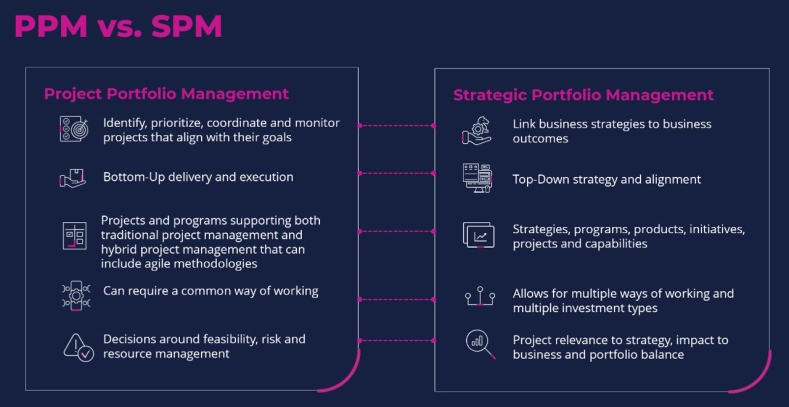Strategic Portfolio Management (SPM) is the confluence of vision and execution. It's the art and science of aligning your project portfolio with overarching strategic business goals. This approach ensures that your efforts, resources, and investments contribute to a greater imperative that drives home your organizational objectives. In short, SPM is where your vision for the future and the actions to make it happen come together.
Bridging PPM and SPM
As organizations face multifaceted challenges, the integration of Project Portfolio Management (PPM) with SPM becomes increasingly indispensable. While PPM ensures efficient project execution, SPM aligns these projects with the broader business strategy, enhancing responsiveness and relevance in a volatile market. This combination helps firms to manage projects with precision while also ensuring that every project decision supports overarching strategic goals.
Adopting SPM alongside traditional PPM practices offers the dual advantage of operational excellence and strategic agility. This approach is crucial for businesses to thrive, making the transition to SPM an essential strategy for those looking to maintain a competitive advantage and drive long-term success.

Today’s world moves fast, especially with all the new tech, fierce global competition, and ever-changing market conditions. PPM is all about keeping projects on track and within budget. SPM ties projects directly to the big-picture goals of a business, ensuring they line up with long-term plans. It's about understanding the significance of each project in the grand scheme and weaving the individual chapters of these projects into a unified narrative that spells strategic success.
This alignment is extremely important. Companies must deal with innovative technologies popping up, market ups and downs, changing customer preferences, new rules, tough competition, cyber threats, and changing ways of working. SPM is here to help companies use these changes for long-term wins. It’s about preparing and planning to be ready for what is coming, which is why SPM is a game-changer to stay on top.
SPM in Practice: Beyond Theory
Implementing SPM means embracing a culture where every project decision is a strategic decision! It requires a thorough understanding of organizational goals and a meticulous alignment of projects with these objectives. This is a dynamic, continuous process of adaptation and realignment.
A robust SPM approach also necessitates a deep dive into data and analytics. Understanding past performance, predicting future trends, and making data-driven decisions is at the heart of SPM. This ensures that every project makes business sense individually, and collectively pushes the organization towards its strategic ‘North Star.’
The PMO Maturity and SPM Mastery Connection
SPM isn't just a methodology; it's a barometer of an organization's Enterprise Project Management Office (PMO) maturity. Mastering SPM techniques signifies a PMO's evolution from basic project management to strategic portfolio oversight. This evolution marks a shift from focusing on tactical project completion to strategic project selection and prioritization.
Organizations with mature PMOs, Enterprise PMOs (EPMOs), or a Transformation office can adeptly manage their SPM like skilled captains navigating their ships through uncharted waters. They understand the ebbs and flows of the market and can deftly steer their project portfolios in alignment with their strategic vision. These organizations will thrive because they turn challenges into opportunities for growth and innovation. They know how to prepare their employees’ change readiness skills to adopt a change in strategy.

Reaping the Rewards of SPM Expertise
The rewards of mastering SPM are multifaceted. First, it leads to improved decision-making. With a comprehensive portfolio view, leaders make informed choices and prioritize investments that offer the highest strategic value. This clarity in decision-making reduces waste and optimizes investment.
SPM mastery enhances organizational agility. In a business landscape where change is constant, the ability to pivot quickly is invaluable. Organizations that excel in SPM adapt their project portfolios swiftly in response to internal and external changes, continuing alignment with strategic goals.
Another reward is enhanced stakeholder engagement and satisfaction. A well-managed SPM framework keeps stakeholders informed and involved, fosters transparency and trust. This ensures that chosen projects are strategically aligned and have the approval from all key stakeholders, enhancing the likelihood of success.
Finally, organizations that excel in SPM position themselves as leaders in their respective industries. By demonstrating an ability to align projects with corporate strategy effectively, they highlight their commitment to long-term vision and sustainable growth. This commitment often translates into a competitive advantage, boosting revenue, attracting customers, investors, and top talent.
Steering Towards Strategic Success
More than just a set of practices, SPM is a critical component of organizational success. Organizations that master SPM achieve higher PMO maturity, clearer vision, enhanced agility, improved stakeholder engagement, and a more competitive edge.
Mastering SPM will increasingly become a distinguishing factor between organizations that lead and those that follow. For companies looking to chart new courses in their industries, investing in SPM is not just wise; it's imperative.
Discover how Planisware can transform your vision into reality through streamlined Strategic Portfolio Management!
Forrester Names Planisware a Leader in Strategic Portfolio Management Tools. Read more.



